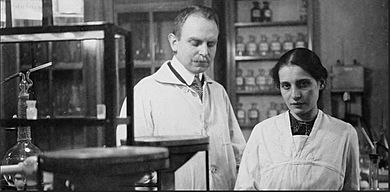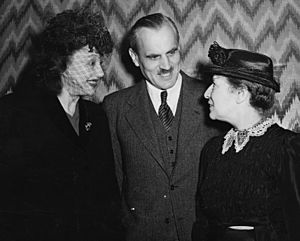Lise Meitner facts for kids
Quick facts for kids
Lise Meitner
|
|
|---|---|

Lise Meitner in 1946
|
|
| Born | 7 November 1878 |
| Died | 27 October 1968 (aged 89) Cambridge, England
|
| Citizenship | Austria (pre-1949), Sweden (post-1949) |
| Alma mater | University of Vienna |
| Known for | Nuclear fission |
| Awards |
|
| Scientific career | |
| Fields | Physics |
| Institutions | Kaiser Wilhelm Institute University of Berlin, Manne Siegbahn Laboratory University College of Stockholm |
| Doctoral advisor | Franz S. Exner |
| Other academic advisors | Ludwig Boltzmann Max Planck |
| Doctoral students | Arnold Flammersfeld Kan-Chang Wang Nikolaus Riehl |
| Other notable students | Max Delbrück Hans Hellmann |
| Influenced | Otto Hahn |
| Signature | |
Lise Meitner ( lee-ZƏ-_-MYTE-nər born Elise Meitner, 7 November 1878 – 27 October 1968) was an Austrian-Swedish physicist who was one of those responsible for the discovery of the element protactinium and nuclear fission. While working on radioactivity at the Kaiser Wilhelm Institute of Chemistry in Berlin, she discovered the radioactive isotope protactinium-231 in 1917. In 1938, Meitner and her nephew, the physicist Otto Robert Frisch, discovered nuclear fission. She was praised by Albert Einstein as the "German Marie Curie".
Contents
Early years
Meitner was born Elise Meitner on 7 November 1878 into a Jewish upper-middle-class family at the family home in 27 Kaiser Josefstraße in the Leopoldstadt district of Vienna, the third of eight children of chess master Philipp Meitner and his wife Hedwig. The birth register of Vienna's Jewish community lists her as being born on 17 November 1878, but all other documents list her date of birth as 7 November, which is what she used. Her father was one of the first Jewish lawyers admitted to practice in Austria. She had two older siblings, Gisela and Auguste (Gusti), and four younger: Moriz (Fritz), Carola (Lola), Frida and Walter; all ultimately pursued an advanced education. Her father was a confirmed freethinker, and she was brought up as such. As an adult, she converted to Christianity, following Lutheranism, and was baptised in 1908; her sisters Gisela and Lola converted to Catholic Christianity that same year. She also adopted a shortened name "Lise".
Education
Meitner's earliest research began at age eight, when she kept a notebook of her records underneath her pillow. She was particularly drawn to mathematics and science, and first studied colours of an oil slick, thin films, and reflected light. Women were not allowed to attend public institutions of higher education in Vienna until 1897, and she completed her final year of school in 1892. Her education included bookkeeping, arithmetic, history, geography, science, French and gymnastics.
The only career available to women was teaching, so she trained as a French teacher. Her sister Gisela passed the Matura, and entered medical school in 1900. In 1899, Meitner began taking private lessons with two other young women, cramming the missing eight years of secondary education into just two. Physics was taught by Arthur Szarvasy. In July 1901, the girls sat an external examination at the Akademisches Gymnasium. Only four out of fourteen girls passed, including Meitner and Henriette Boltzmann, the daughter of physicist Ludwig Boltzmann.
Meitner entered the University of Vienna in October 1901. She was particularly inspired by Boltzmann, and was said to often speak with contagious enthusiasm of his lectures. Her dissertation was supervised by Franz Exner and his assistant Hans Benndorf. Her thesis, titled Prüfung einer Formel Maxwells ("Examination of a Maxwell Formula"), was submitted on 20 November 1905 and approved on 28 November. She was examined orally by Exner and Boltzmann on 19 December, and her doctorate was awarded on 1 February 1906. She became the second woman to earn a doctoral degree in physics at the University of Vienna, after Olga Steindler who had received her degree in 1903; the third was Selma Freud, who worked in the same laboratory as Meitner, and received her doctorate later in 1906. Meitner's thesis was published as Wärmeleitung in inhomogenen Körpern ("Thermal Conduction in Inhomogeneous Bodies") on 22 February 1906.
Paul Ehrenfest asked her to investigate an article on optics by Lord Rayleigh that detailed an experiment that produced results that Rayleigh had been unable to explain. She was not only able to explain what was going on; she went further and made predictions based on her explanation, and then verified them experimentally, demonstrating her ability to carry out independent and unsupervised research.
While engaged in this research, Meitner was introduced by Stefan Meyer to radioactivity, then a very new field of study. She started with alpha particles. In her experiments with collimators and metal foil, she found that scattering in a beam of alpha particles increased with the atomic mass of the metal atoms. Later on, this led Ernest Rutherford to predict the nuclear atom. She submitted her findings to the Physikalische Zeitschrift on 29 June 1907.
Scientific career
Meitner spent most of her scientific career in Berlin, Germany, where she was a physics professor and a department head at the Kaiser Wilhelm Institute; she was the first woman to become a full professor of physics in Germany. She lost these positions in the 1930s because of the anti-Jewish Nuremberg Laws of Nazi Germany, and in 1938 she fled to Sweden, where she lived for many years, ultimately becoming a Swedish citizen.
In mid-1938, Meitner with chemists Otto Hahn and Fritz Strassmann at the Kaiser Wilhelm Institute found that bombarding thorium with neutrons produced different isotopes. Hahn and Strassmann later in the year showed that isotopes of barium could be formed by bombardment of uranium. In late December, Meitner and Frisch worked out the physics of such a splitting process. In their report in February issue of Nature in 1939, they gave it the name "fission". This principle led to the development of the first atomic bomb during World War II, and subsequently other nuclear weapons and nuclear reactors.
Meitner’s discoveries made possible the atomic bomb that was dropped on Hiroshima. In the aftermath of the bombing, Meitner found that she had become a celebrity. She had a radio interview with Eleanor Roosevelt. Meitner lectured at Princeton University, Harvard University and Columbia University, and discussed physics with Albert Einstein, Hermann Weyl, Tsung-Dao Lee, Yang Chen-Ning and Isidor Isaac Rabi.
Meitner did not share the 1944 Nobel Prize in Chemistry for nuclear fission, which was awarded exclusively to her long-time collaborator Otto Hahn. Several scientists and journalists have called her exclusion "unjust". According to the Nobel Prize archive, she was nominated 19 times for the Nobel Prize in Chemistry between 1924 and 1948, and 30 times for the Nobel Prize in Physics between 1937 and 1967. Despite not having been awarded the Nobel Prize, Meitner was invited to attend the Lindau Nobel Laureate Meeting in 1962. She received many other honours, including the naming of chemical element 109 meitnerium after her in 1997.
Later life
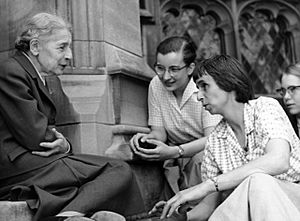
Meitner retired in 1960 and moved to the UK where most of her relatives were, although she continued working part-time and giving lectures.
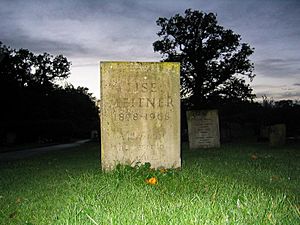
A strenuous trip to the United States in 1964 led to Meitner's having a heart attack, from which she spent several months recovering. Her physical and mental condition weakened by atherosclerosis. After breaking her hip in a fall and suffering several small strokes in 1967, Meitner made a partial recovery, but eventually was weakened to the point where she moved into a Cambridge nursing home. Meitner died in her sleep on 27 October 1968 at the age of 89. As was her wish, she was buried in the village of Bramley in Hampshire, at St James parish church, close to her younger brother Walter, who had died in 1964. Her nephew Frisch composed the inscription on her headstone. It reads:
Lise Meitner: a physicist who never lost her humanity.
Awards and honours
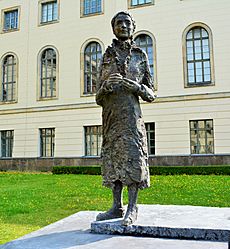
Meitner was praised by Albert Einstein as the "German Marie Curie". On her visit to the US in 1946, she received the honour "Woman of the Year" from the National Press Club and had dinner with the President of the United States, Harry S. Truman, at the Women's National Press Club. She received the Leibniz Medal from the Prussian Academy of Sciences in 1924, the Lieben Prize from the Austrian Academy of Sciences in 1925, the Ellen Richards Prize in 1928, the City of Vienna Prize for science in 1947, Max Planck Medal of the German Physical Society jointly with Hahn in 1949, the inaugural Otto Hahn Prize of the German Chemical Society in 1954, the Wilhelm Exner Medal in 1960, and in 1967, the Austrian Decoration for Science and Art. The President of Germany, Theodor Heuss, awarded her the highest German order for scientists, the peace class of the Pour le Mérite in 1957, the same year as Hahn. Meitner became a foreign member of the Royal Swedish Academy of Sciences in 1945, and a full member in 1951, permitting her to participate in the Nobel Prize process. Four years later she was elected a Foreign Member of the Royal Society. She was also elected a Foreign Honorary Member of the American Academy of Arts and Sciences in 1960. She received honorary doctorates from Adelphi College, the University of Rochester, Rutgers University and Smith College in the United States, the Free University of Berlin in Germany, and the University of Stockholm in Sweden.
In September 1966 the United States Atomic Energy Commission jointly awarded the Enrico Fermi Award to Hahn, Strassmann and Meitner for their discovery of fission. The ceremony was held in the Hofburg palace in Vienna. It was the first time that this prize had been awarded to non-Americans, and the first time it was presented to a woman. Meitner's diploma bore the words: "For pioneering research in the naturally occurring radioactivities and extensive experimental studies leading to the discovery of fission". Hahn's diploma was slightly different: "For pioneering research in the naturally occurring radioactivities and extensive experimental studies culminating in the discovery of fission." Hahn and Strassmann were present, but Meitner was too ill to attend, so Frisch accepted the award on her behalf. Glenn Seaborg, the discoverer of plutonium, presented it to her in the home of Max Perutz in Cambridge on 23 October 1966.
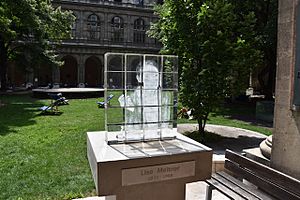
After her death in 1968, Meitner received many naming honours. In 1997, the element 109 was named meitnerium. She is the first and so far the only non-mythological woman thus exclusively honoured (since curium was named after both Marie and Pierre Curie). Additional naming honours are the Hahn–Meitner-Institut in Berlin, craters on the Moon and Venus, and the main-belt asteroid 6999 Meitner. In 2000, the European Physical Society established the biannual "Lise Meitner Prize" for excellent research in nuclear science. In 2006 the "Gothenburg Lise Meitner Award" was established by the University of Gothenburg and Chalmers University of Technology in Sweden; it is awarded annually to a scientist who has made a breakthrough in physics. In October 2010, the building at the Free University of Berlin that had once housed the KWI for Chemistry, and was known as the Otto Hahn Building since 1956, was renamed the Hahn-Meitner Building, and in July 2014 a statue of Meitner was unveiled in the garden of the Humboldt University of Berlin next to similar statues of Hermann von Helmholtz and Max Planck.
Schools and streets were named after her in many cities in Austria and Germany, and a short residential street in Bramley, her resting place, is named Meitner Close. Since 2008 the Austrian Physical Society together with the German Physical Society have organized the Lise Meitner Lectures, a series of annual public talks given by distinguished female physicists, and since 2015 the AlbaNova University Centre in Stockholm has an annual Lise Meitner Distinguished Lecture. In 2016, the Institute of Physics in the UK established the Meitner Medal for public engagement within physics. In 2017, the Advanced Research Projects Agency-Energy in the United States named a major nuclear energy research program after her. On 6 November 2020, a satellite named after her (ÑuSat 16 or "Lise", COSPAR 2020-079H) was launched into space.
Related pages
Images for kids
-
Physicists and chemists in Berlin in 1920. Front row, left to right: Hertha Sponer, Albert Einstein, Ingrid Franck, James Franck, Lise Meitner, Fritz Haber, and Otto Hahn. Back row, left to right: Walter Grotrian, Wilhelm Westphal, Otto von Baeyer, Peter Pringsheim and Gustav Hertz
-
Former Kaiser Wilhelm Institute for Chemistry building in Berlin. Badly damaged by bombing during World War II, it was restored and became part of the Free University of Berlin in 1948. It was renamed the Otto Hahn Building in 1956, and the Hahn-Meitner Building in 2010.
-
At a conference in 1937, Meitner shares the front row with (left to right) Niels Bohr, Werner Heisenberg, Wolfgang Pauli, Otto Stern and Rudolf Ladenburg; Hilde Levi is the only other woman in the room.
See also
 In Spanish: Lise Meitner para niños
In Spanish: Lise Meitner para niños



